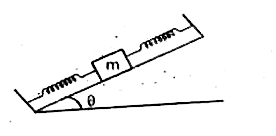A body is in SHM with period T when oscillated from a freely suspended spring. If this spring is cut in two parts of length ratio 1:3& again oscillated from the two the two parts separatedly, then the periods are T1&T2 then find T1/T2.
The correct Answer is:1/√3
To solve the problem, we need to find the ratio of the periods T1 and T2 of two parts of a spring that has been cut into a ratio of 1:3. We will use the properties of springs and the formula for the period of oscillation in simple harmonic motion (SHM).
1. Understanding the Spring Constant:
The spring constant k is inversely proportional to the length of the spring. If the original length of the spring is L, and it is cut into two parts with lengths L1 and L2 in the ratio 1:3, we can express:
L1=L4andL2=3L4
2. Finding the Spring Constants:
The spring constant k for a spring is given by the formula:
k=KL
where K is a constant. Thus, for the two parts:
- For L1:
k1=KL1=KL4=4KL
- For L2:
k2=KL2=K3L4=4K3L
3. Using the Period Formula:
The period T of a mass m attached to a spring is given by:
T=2π√mk
Therefore, we can find T1 and T2:
- For T1:
T1=2π√mk1=2π√m4KL=2π√mL4K=T2
- For T2:
T2=2π√mk2=2π√m4K3L=2π√3mL4K=√3⋅T2
4. Finding the Ratio T1T2:
Now we can find the ratio of the two periods:
T1T2=T2√3⋅T2=1√3
Final Result:
Thus, the ratio of the periods T1 and T2 is:
T1T2=1√3
The spring constant k is inversely proportional to the length of the spring. If the original length of the spring is L, and it is cut into two parts with lengths L1 and L2 in the ratio 1:3, we can express:
L1=L4andL2=3L4
The spring constant k for a spring is given by the formula:
k=KL
where K is a constant. Thus, for the two parts:
- For L1:
k1=KL1=KL4=4KL
- For L2:
k2=KL2=K3L4=4K3L
The period T of a mass m attached to a spring is given by:
T=2π√mk
Therefore, we can find T1 and T2:
- For T1:
T1=2π√mk1=2π√m4KL=2π√mL4K=T2
- For T2:
T2=2π√mk2=2π√m4K3L=2π√3mL4K=√3⋅T2
Now we can find the ratio of the two periods:
T1T2=T2√3⋅T2=1√3
Thus, the ratio of the periods T1 and T2 is:
T1T2=1√3
Similar Questions
The time period of a mass suspended from a spring is T. If the spring is cut into four equal parts and the same mass is suspended from one of the parts, then the new time period will be
View SolutionTime period of a block with a spring is T0. Now ,the spring is cut in two parts in the ratio 2:3. Now find the time period of same block with the smaller part of the spring.
View Solution
Knowledge Check
- Question 1 - Select One
Time period of a spring mass system is T.If this spring is cut into two parts whose lengths are in ratio 1:3 and the same mass is attached to the longer part, the new time period will be
A√32TBT√3C√3T2D√3T - Question 2 - Select One
The time period of a spring - mass system is T. If this spring is cut into two parts, whose lengths are in the ratio 1:2, and the same mass is attached to the longer part, the new time period will be
A√13TB√23TC√3T2D√3T - Question 3 - Select One
The time period of a mass suspended from a spring is T if the spring is cut in to equal part and the same mass is suspended from one of the pert then the time period will be
ATBT2C2TDT4
The period of oscillation of a spring pendulum is T. If the spring is cut into four equal parts, then find the time period corresponding to each part.
View Solution
The period of oscillation of a mass M suspended from a spring of spring constant K is T. the time period of oscillation of combined blocks isView SolutionThe time period of a mass suspended from a spring is T. If the spring is cut into four equal parts and the same mass is suspended from one of the parts, then the new time period will be:
View SolutionThe period of oscillation of a freely suspended bar magnet is 4 second. If it is cut into two equal parts length wise then the time period of each part will be
View SolutionA uniform spring has certain mass suspended from it and its period for vertical oscillation is T1. The spring is now cut into two parts having the lengths in the ratio of 1:2 and same mass is suspended with those two spring as shown in figure. Now time period is T2. The ratio T1/T2 is
 View Solution
View Solution

